An interview with Electric Guitar Designer Bill Compeau
Hello fellow Guitar Design fans, Kerry Kruger here…in the last year or so I wrote several articles on how I look at guitar design, and I thank those of you who read them and offered any feedback. There really wasn’t a lot of that though, and I admit I got a little distracted from the endeavour. ( I apologize to anyone out there waiting for my next installment.) However, one day this last April I got an email from a like-minded soul who had been following them, and wanted to get a back-and-forth going, even asking my opinion on some of his designs. So, not having a whole lot going on, I responded, with as much objective commentary as I felt wouldn’t hurt, as he was actually quite good, especially for as short a time as he said he’d been at it.
Well he got right back to me, having expected the sort of non-committed blow off we all foresee these days, and we’ve been commiserating and collaborating ever since, being very much in the same boat of honing our skills and gaining acceptance in a strange and esoteric business. I’m the kind of guy who has a very critical eye, and will say so if I see something out of whack, but as tactfully as possible, and usually suggesting a fix, and he seems to appreciate that. I’ve designed just under 250 models now, so I’ve made most of the mistakes anyone trying to learn this discipline has to overcome. And I’ve tried to make custom headstocks for all of them, it’s actually a more limited, constrained art form. Of course many of one’s designs will be somewhat experimental, and they can’t all be successful. So I have a trove of heads and bodies that may be orphaned, without mates…and in an oddly synchronistic way, it seems whenever Bill is stuck on something (usually a headstock), I’ve found one of mine that wasn’t doing anything and just fills the bill, or is darn close, needing only a brief tweak to complement the
model. So that’s been very satisfying, I think, for both of us.
He didn’t really let on at first all the music-business experience he had, and I enjoyed discovering his background, which was far more impressive than he let on. So, I decided that, having this Forum to help him gain a wider audience, I’d do a loose Interview and let you all get to know him as I have.
The full interview between myself, Kerry Kruger at Guitar Design Reviews (KK) and Guitar Designer Bill Compeau (BC) is below.
Guitar fans, get to know Bill Compeau…
KK. First, the basics, how old are you, and where are you from?
BC. I am now 48 years old, I was born in Detroit Michigan.
KK. Where did you get your education, and what did you mostly study?
BC. I only spent a Semester at Western Michigan University, Voice Major and Piano minor was my area of study. I left school to work in a real band again with my old schoolmate and now fellow Ark Amp partner Matt Schellenberg, we were quite driven to “make it” at the time.
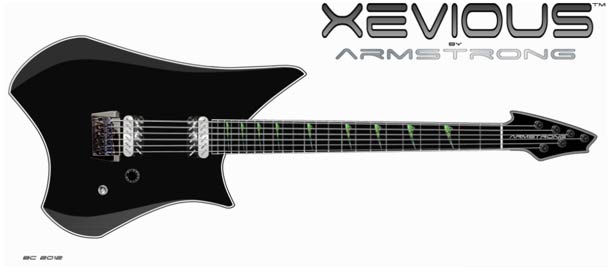
KK. I know you were a working musician for some time, how was that, and how could we catch up on your music? Do you still play?
BC. Well I never made very much money playing music, my main goal was to write and record original music and possibly land a decent recording contract allowing me to make somewhat of a living doing only music. I eventually was offered a deal with an independent label but turned it down, I didn’t feel they were a good fit after seeing the kind of artists they had on their label.
My main “Gig” these days is with the Progressive Rock band Territorial Chant, it is with fellow Ark Amp man (and CEO) Matt Schellenberg, the band has been around in various forms since 1987; I am the main guitarist and one of the main writers. We have been working on the last album since 2004, we are pretty close to finishing it (finally!!!) Some of the songs can be heard here: www.soundlift.com/territorialchant
KK. Tell me about your associations with ARK and Armstrong Amps?
BC. My band and former school mate Matt Schellenberg moved back from Budapest in 2003 after 7 years away which is when we re-started the band. He had a new baby on the way and wanted to continue home-schooling his children so he asked me if there was something we could do that would allow him to work out of his Garage. I told him about an amp design that was laying around for a while that would probably sell so we just went with that. I had the name Ark Amps in my head for a little while, he liked it and quickly designed the logo for it as he is the main artist behind Ark Amps. Matt is an award winning artist and sculptor and obviously a big influence on what I would eventually become myself. The first model for Ark was based on my original design called the Aviator; Matt then designed his wild looking version called the Model A. I co-designed the Model D and Model T amplifiers as well. I am mainly the sales and artist relations guy for Ark these days.
I started Armstrong Amps in 2010 as a way to express my artistic side a little more and do something radically different than Ark, I named the company after my 7th grade music Teacher Linda Armstrong who made a big impact on me and helped form me into the musician and singer I am today. Neal Armstrong was also part of the inspiration as my love for War planes and Space travel as a child has stuck with me to this day.
Shortly after starting the amp side of the company I began dabbling again with Guitar design in my spare time and was surprised that all of a sudden I was able to draw at a level I only dreamed of before. My mother and Sister were always good artists but I never thought I had that side to me. I really thought that music was the only real artistic gift that I possessed; I guess it was a “latent” ability meant to surface later in my life when the time was right for me to be able to actually DO something with such a gift!
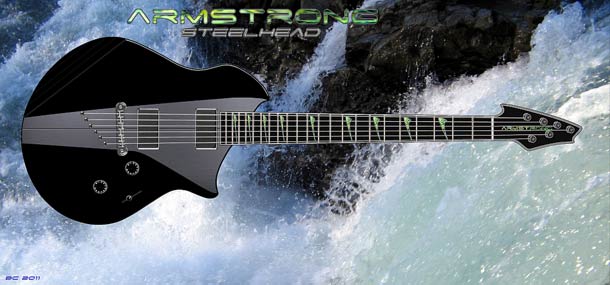
KK. Your ARK cabinets in particular are off-the charts cool, did you have any background in woodworking that led to your making those so free-flowing and wild? (Or did you just design what pleased you and make someone else get it done? )
BC. Matt Schellenberg handles all the wood working chores for Ark, I was the “solder-sniffer” and sales guy as well as a co-designer, but Matt’s style is most of what is seen in the Ark products, Armstrong Amps is 100% my designs and style. I do have a background as a carpenter which has proven helpful in designing some of the unique features and unique tones of Ark’s resonant speaker cabs. Ark is on the cover of the recent Amp Bluebook, a huge thrill to say the least!
KK. Where do you stand now with each company, if that’s not too personal…
BC. I am the sales and Artist Relations man for Ark and the owner of Armstrong Guitars and Amps..

KK. Were your parents and family artistic? If not, what kind of skills did they have?
BC. Both my parents are musical, my Mom is a good singer and used to play guitar and my Dad is a good keyboard player who was signed to Big Top Records in the ’60’s. My brother Adam and myself seemed to get all their talents and more as we both play many instruments as well as sing and compose music. My brother is also an amazing Trumpeter and has played with some famous jazz heavy weights.
KK. You’ve told me you never saw yourself as artistic per se, what prompted you to branch off into guitar design?
BC. I always dreamed of designing my own guitar and was always a “tinkerer” which led to my job working as a guitar tech at Motor City Guitar in the mid ’90’s. I learned a lot during my time there and can honestly say I have never set foot in a finer music store! One time I repaired a distortion pedal for a tech for a band on tour in our area only to find out later that that pedal belonged to the one and only Leslie West of Mountain! That was probably my first work for I did for a famous musician.
KK. Was there some sort of epiphany, and when did that take hold?
BC. When I designed the first Ark Concept Guitar called the Arrow in June 2010 I realized that I really did now have the ability to design on a high enough level to keep at it, that project gave me the inspiration and confidence to continue down that creative path.
KK. Do you have any favorite guitar-designers that have inspired you, or that you hope to follow?
BC. For many years I was quite infatuated with the Dean Cadillac and that influence is certainly not hard to see in some of my own designs. There was such an attitude and “electricity” that guitar seemed to convey that made me crave owning one for many years. It also helped that my biggest musical influence: Kerry Livgren of Kansas was one of the earliest artists to play those guitars. I think he still owns one of the very first ones and I got to strum it briefly back in the ’80’s when Kerry’s other band at the time called “AD” came to Detroit. I recall hanging out with the band early before the show, I then befriended the sound man who was secretly hoping I could be groomed as his replacement and I actually hand wrote the set list for all the band members that night based off the one Kerry wrote on a napkin. During the performance I stood side stage and strummed all the guitars on Kerry’s large rack of guitars of which his trusty old Black Cadillac was one. I will always remember that amazing night…
Since that time my inspirations have come from men like Phil Kubicki, BC Rich, Ned Steinberger, Ken Parker, Peter Malinoski, John Backlund, Scott Walker, Bertram Dehellemmes to name a few. There are many guitar inspirations from the ’60’s and ’70’s as well like the old Yamaha’s and the Ovation Breadwinner for example..
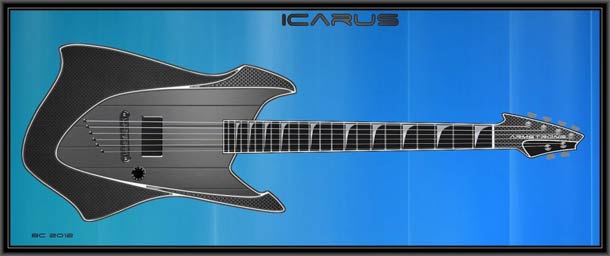
KK. What motivates new models for you, and who do you hope to reach as a target audience?
BC. Many times I am inspired by existing guitar designs as well as well designed cars and cool looking planes and Jets. Some models are even inspired by fish like my Steelhead and Orca models. It seems I am always looking at objects I see during the day and picturing a guitar neck on it, I actually have some models that came about in that way.
My target audience is players who want a high performance guitar or bass (or amp;>) that has that certain “Hotrod” look they just have to have.
That is the case with the first custom made SR-71 we are building for the talented band FairSkies, they saw the design and just HAD to have it as their main stage guitar for their new image and direction as a band. I am hoping to build a custom guitar this fall for a famous player soon who will remain un-named for the moment, he has already picked the one he wants, it is the Steelhead model. Obviously I want to continue build for more pro players for the increased exposure to my guitars, but I really do enjoy working with “working” musicians on their dream guitar, bass or amplifier.
KK. Do you have a favorite aspect, or part of the guitar that seems to hold together as a theme, or signature of your ‘hand’?
BC. Hmm, I suppose the use of longer lower horns like on the Dean Cadillac would be a recognizable feature on many of my designs. But the main thing I tend to shoot for is a guitar or bass that has the feeling of motion to it, or at least the look of being ready to take off like a dragster or hotrod that is brake-torquing. I also lean towards a look that has an aero-dynamic vibe to it.
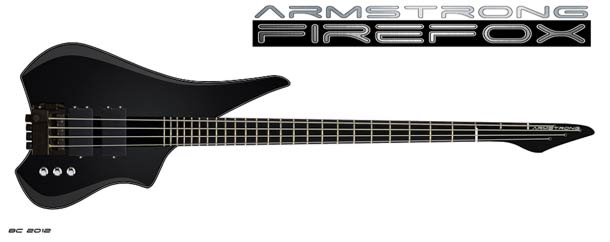
KK. Is there a part of the guitar you tend to design first and then work around that?
BC. I always start with the body shape, which can start as a circle, square or some other shape that I carve away at until I have something that resembles a guitar or bass. I don’t think too much about a headstock until I finalize the body enough to justify doing it. I usually dread designing headstocks but I have been fortunate to have the help of a certain Kerry Kruger when I get stuck;>)
KK. Have you had many instruments produced, and how did that get done?
BC. There are only a handful of my designs built so far, after all this is a new company and not that many players have heard of me yet. I have 4 builders I work with in building my instruments: Bruce Bennett, Cavey’s Clubs, Sweetwood Guitars and Zion Guitars. These builders have the skills needed to build to the high level I require and they are excellent people to deal with as well.
KK. Have your cooperations been particularly businesslike and contract-y, or more a handshake kind of deal?
BC. It depends, most of the time no contracts are needed as I am pretty much friends with all my builders. With customers I get a deposit and then start the build which eliminates any money problems that way.
KK. You seem to have a special bond with bass players in your area, how did that come about?
BC. I suppose it is because of my time working at Motor City Guitar which is a very popular hang out, and it doesn’t hurt that I am a bassist myself and enjoy interacting with other bassists whenever I can.
KK. What’s surprised you most about doing guitar design, bringing new ideas to light?
BC. Probably the fact that many times (at least lately) new designs get finished very quickly with only a few corrections along the way, and sometimes with the help and guidance of other designers and builders who are kind enough to lend their eyes to point out things my overly “biased” eyes seem to miss sometimes. In the beginning I had to spend large amounts of time on one model and still sometimes it ended up in the trash can. It seems I have honed my skills to the point where my hands just know where to go now without spending weeks trying to find that elusive “it” factor us designers are always looking for.
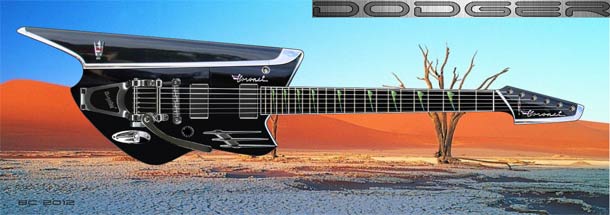
KK. Is there anything big in the works we should be looking forward to?
BC. There is a large exclusive deal in the works with an American Music Store as well as a large Korean production planned for one of my newer models early next year. If these plans go through it will give me the operating capital I need to build up stock of some of my favorite models to take to trade shows and also do some “tours” where players can try them at home for a week to see if they bond with the instrument; that is a fairly new way of marketing that seems to work quite well for some boutique companies.
I have recently had the honor of being asked to be a sales rep for one of my favorite Guitar companies: JBacklund Designs, which also happens to be one of my biggest influences as a designer!
KK. Well thanks for your answers, I’ve really enjoyed collaborating with you these last few months, and look forward to your continued success. Any final words of wisdom?
BC. Well I really appreciate the opportunity to share my experiences on this great website and I hope this somehow inspires others to express their creative side a little more and maybe design (and build) their very own guitar!
As far as advice goes all I can add is that it does not really matter what others may tell you, if you really have the desire to try something new just go for it, you never can tell where it may lead you. Many of my friends in the boutique amp and guitar world started building as a hobby and that hobby ended up getting so big that they had to quit their day job!!!
